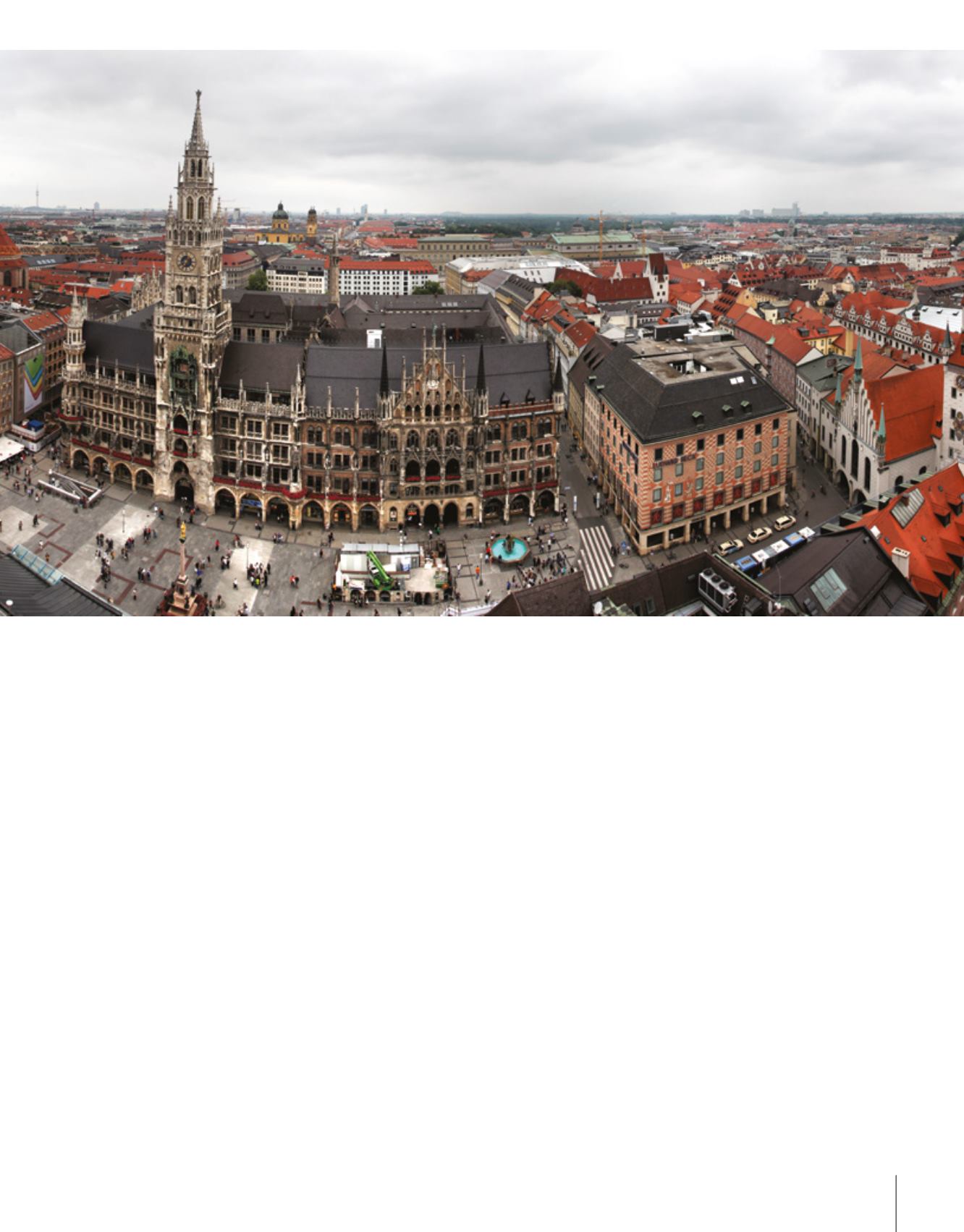
117
Karlstor'dan eski şehrin kalbi
sayılan Marienplatz'a doğru
uzanan araç trafiğine kapalı
cadde Neuhauser. Yoğun
kalabalığı, satıcıları, sokak
sanatçıları ve renkliliği ile bir
klasiğe imza atarak İstiklal
Caddesi'ne benzetmek
mümkün. Bu caddede
dolaşırken daha yoğun olmakla
birlikte Münih sokaklarında
dikkatinizi yerel kıyafetler
giymiş olan her yaştan
Bavyeralılar çekecek. Bunun
bir festival ya da özel gün
olduğunu düşünebilirsiniz.
Ancak Münih için oldukça
normal sayılan bir durum.
Bavyera kültürüne sahip
çıkan kentliler haftanın bir
iki gününde, büyük paralar
dökerek satın aldıkları işlemeli
ve el yapımı olan bu orijinal
folklorik kıyafetleri tercih
etmekteler. İzmir sokaklarında
Zeybek ya da Bursa
sokaklarında Kılıç Kalkan
kıyafetleriyle dolaşan insanlar
hayal edin ve bunun turistler
dışında kimsenin ilgisini
çekmediğini düşünün, benzer
bir durum söz konusu.
Marienplatz yönünde yolun
solunda göreceğiniz 100 m.
yükseklikteki soğan şeklinde
kubbeli ikiz kuleleriyle
göz kırpan devasa kilise
Frauenkirche. Şehrin en
önemli ikonik yapısı olan 15.yy
yapımı 20.000 kişi kapasiteli
bu “sevgili leydi kilisesi”nin
güney kulesi tırmanmak için
sizi bekliyor. Gökyüzünün açık
olduğu bir günde Alp Dağları’nı
da vaat eden manzarasıyla
şehri tepeden izlemek için en
iyi noktalardan birindesiniz.
Yorulduğunuza değecek.
Şehrin kalbi olan biraz ilerideki
Marienplatz XII. yüzyıldan bu
yana Münih’in ana merkezi.
Ortaçağ'da tuz ve tahıl pazarı
olarak kullanılan; St. Peter
Kilisesi, eski belediye sarayı
Altes Rathaus ve görkemli
yeni belediye sarayı Neues
Rathaus binaları ile çevrili,
magnificent new city hall Neues
Rathaus buildings and it is a
cozy square that opens up to
the Kaufinger shopping street.
The new city hall dominating the
square has become the symbol
of Munich and interestingly it
has a much older and attractive
view than the older one. The
clock on the tower of Neues
Rathaus building ornamented
with dragons and Bavarian
legends and historical figures
starts moving at 11:00 and 12:00.
All eyes at the square turn up.
The giant cuckoo clock that
makes a short show depicting
a dance or duel of Bavarian
figurines celebrating the end of
the plague turns the square into
an even more attractive place.
This assertive Gothic Revival
type structure that has been
built during 1867 and 1908 and
actually almost all the historical
buildings at Altstadt have been
damaged heavily during the
bombardment by the Allied
Forces during the 2nd World War.
Despite this, all the historical
buildings have been restored to
their original states and some
have even been built again.
After taking a city map from the
tourist information booth under
Neues Rathaus at Marienplatz,
you can try the nearby restaurant
named Ratskeller. This restaurant
at the most touristic location of
the city should be visited since
we are tourists after all. It is a
nice alternative for aficionados
due to its authentic decoration
as well as its Bavarian cuisine.
However, do not get caught in
the taste and variety of the beers
and think that German cuisine
should also be quite attractive.
Leaving out the duck and apple
desserts, Bavarian cuisine does
not have many dishes that suit
our tastes. St. Peter Church,
the oldest building of the old
square is located right across.
St. Peter Church is really a
work of art with its gothic style
façade and baroque style interior
architecture. We should state
for aficionados that there are 5
gothic pieces by Jan Polack from
Munich inside the building. The
square in front of the building
with the same name, Peterplatz,
is also one of the most touristic
and lively spots of Munich. There
is a nice coffeehouse at the
terrace here. Those who wish to


